
Philadelphia Fullerine is a geodesic narrative montage showing people, events, and themes of ethnic life in mid-19th century Philadelphia. I presented this sculpture at the National Collegiate Honors Conference in New Orleans, IL., which was held on Nov. 10-14, 2004. A multidisciplinary project, it pulls together skills in art, engineering, history, writing, performance, and recording.
Addendum: I presented a paper on the computing and literary theory of Philadelphia Fullerine at the 16th Annual ACM/SIGWEB Conference on Hypertext and Hypermedia, in Salzburg, Austria. My paper won the Ted Nelson Newcomer Award! The title of the paper is "Philadelphia Fullerine, A Case Study in Three Dimensional Hypermedia."
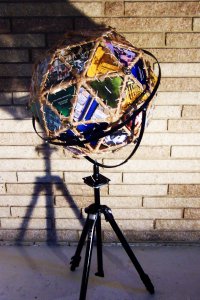 | 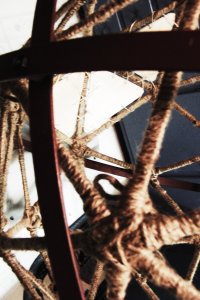 | 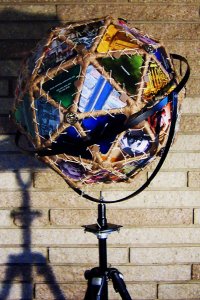 |
The sculpture is an extension of my senior English honors project, which is a traditional narrative nonfiction on the same topic.
On December 21, Lancaster County's Intelligencer Journal featured the sculpture in an article. The article has now been pulled, despite the fact that the newspaper has a form online which agrees to keep the page accessible for those who make certain agreements in return. I have talked to the Intelligencer staff, and they have denied that they have *any* responsibility to do any of this sort of thing, no matter what their website says. Sigh.
If you wish to visit the sculpture at the High library of Elizabethtown College, where you will be able to enjoy the full experience of the sculpture and adjoining audio documentary.
For more information on the article, see the blog post I wrote about the Intelligencer article.Dylan Kinnet and I have been discussing the Philadelphia Fullerine and its relations to hypertext theory and artistic tradition on his blog, Codex. The discussion ranges from quilts to paintings to published hypertext.
Narrative Montage?
At its most basic level, this sculpture is a geodesic sphere featuring images from mid-19th century Philadelphia history. However, much more is going on. Each of the numbered triangles represents a different story or theme from that time period. An attached mp3 device plays a short audio clip explaining the triangle. As much as possible, I use the words of those who were there, including figures like Charles Dickens, Edgar Allan Poe, and Frederick Douglass.
The placement of images on the sphere is not random. Each triangle relates directly to the stories and themes directly adjacent to it. Many more connections exist, but these provide a basic sort of guidance for experiencing the project.
Life is a much richer thing than dots on a timeline or paragraphs in a chronological story. Life doesn't happen independently of itself. In a city like Philadelphia, the actions of one person were not confined to one event or sphere of influence. Furthermore, a single act could be one influence on a multitude of other events and ideas. By presenting this work as a hypertext sphere, I hope to encourage people to read history holistically.
Philadelphia Fullerine is a hypertext. This may seem odd, since it's presented as a sculpture rather than a web-based electronic document. But the WWW is only one small application of the concept of hypertext, which refers to any sort of work that is meant to be read (or experienced) nonlinearly. Hypertext can exist in many forms. It can be used for print works like Ted Nelson's Literary Machines (one of the first conscious hypertexts). It can be used in online literary efforts, such as Dylan Kinnett's fine novella, To Win, Simply Play. Sites like wikipedia rely heavily on hypertext concepts, although not all websites are hypertext.
I may be wrong, but I believe that Philadelphia Fullerine is the first (let's hope of many) hypertext sculptures. Because it's a hypertext, it encourages readers to explore the history and connections for themselves, in whatever order or manner they choose.
The world is not linear, and neither is knowledge. Paper writing and textbooks constrain our thinking to a high degree, making us think in a line, or at best, in hierarchies. There are other, better models for thinking and representing information. While a geodesic sphere is very constraining, it is much much less constraining than, say, a term paper. Logic itself doesn't really go in a line, but actually takes the form of a multiTree or zzStructure.
Thinking outside the constraints of normal hierarchial linearity is a useful too. My talk at the NCHC (on the value of certain types of American Studies courses) touched on the value of teaching honors students the art of making good connections between information. I have already been contacted by a college professor who would like to make a small-scale geodesic sphere an assignment for an honors class.
This project was actually authored in electronic hypertext software, Eastgate Systems' Tinderbox. The sphere is one cross-section of the information, placed into physical space. If you ever have to do complex research or want to write more intelligently, I highly suggest Tinderbox as a writing tool. My methods of research and writing with Tinderbox will be published in an upcoming issue of Tekka, The Journal of New Media and Software Aesthetics.
More information on the role of Tinderbox in making the geodesic sphere can be found on my weblog, The Notebook of Sand.
The Sphere
Philadelphia Fullerine is constructed with a framework of galvanized steel rods, riveted together onto 12 pentagonal and 20 hexagonal connectors. It is a geodesic structure. However, it has 32 vertices, not 60, which is why I haven't named it a Fullerene but have instead changed the spelling slightly.
I obtained most of my mathematical information from the R. Buckminster Fuller FAQ, based on a lot of usenet postings. If you have questions about the math, please go there. Section 4, on Geodesic Domes will be the most helpful page. My sphere is a 2 frequency (what-is-referred-to-in-Domebook II-as) triacon geodesic sphere. It can be thought of as a dodecahedron with each pentagon composed of triangles. Another page, by Maurice Starck, shows a 3d applet of the geometry of Philadelphia Fullerine (the middle one).
The geometry of the steel sphere wrapped with rough jute and hemp cord symbolize the tensions felt between the old, handmade culture and the new, precision-manufacturing working-class that caused economic upheaval in the mid-19th century. At the center of each pentagon is an ornate knob which symbolizes he clash between the refined upper class life and the rougher working-class experience. Note also the choice of jute and hemp. Many of the immigrant workers would have been dockworkers or weavers. They too were losing their jobs to the technologies of cotton mills, railroads, and manufactories.
The triangles are made out of balsa laced onto the structure with hemp cord.
I have been pleased to find other geodesic artists. My favorite sculpture is The Millennium Bookball, one of many beautiful mathematical sculptures by George Hart.
Audio Excerpts
Although I can't reproduce the images online (copyright issues), I can put some excerpts of the audio online (in no particular order):- The Great Firemen's Parade
- The Fugutive Slave Act in Philadelphia
- Quaker Philanthropy: Girard College
- "I fired the first shot on the Moyamensing Killers" --James Williams, escaped slave
- Lager
- Public Education in Philadelphia
- Public Spaces
- The Kensington Railroad War
- Sydney George Fisher
- White Horse or Black? Taverns in Ethnic Experience
- Beat Him Up and Vote Him Out
The background audio for these works was generously provided by Magnatune, which is a thoroughly-tremendous non-evil electronic record label. These works were licensed under an Attribution NonCommercial ShareAlike CC license. The print/multimedia version of the sculpture contains a full list of artists.
Photos of NCHC
I was privileged to take this sculpture to the National Collegiate Honors Conference '04 in New Orleans. There, I presented the sculpture and also gave a talk (collaborated with Dr. Kevin Scott) on how American Studies courses can help bridge cross-cultural gaps. Here are some photos from the trip (courtesy of Kyle C. Kopko):
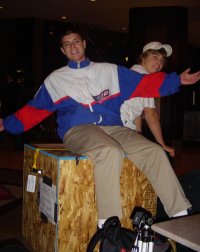 J. Nathan Matias arrives sitting on a box containing a sculpture. Jacob Kanagy is behind him. |
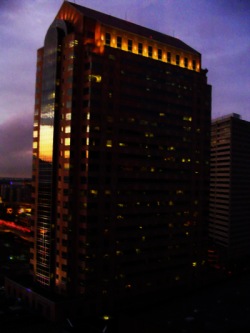 The view out of the hotel room at NCHC '04 |
 The view out of the Hyatt Regency Elevator, New Orleans | |
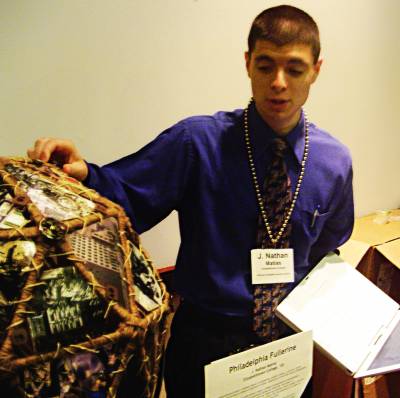 J. Nathan Matias explains the Philadelphia Fullerine |
|
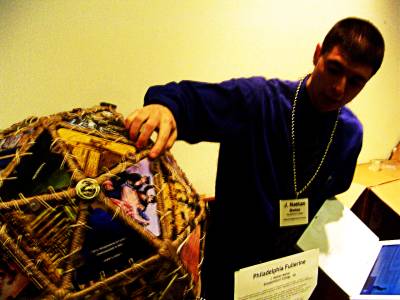 J. Nathan Matias demonstrates the Philadelphia Fullerine some more |
|
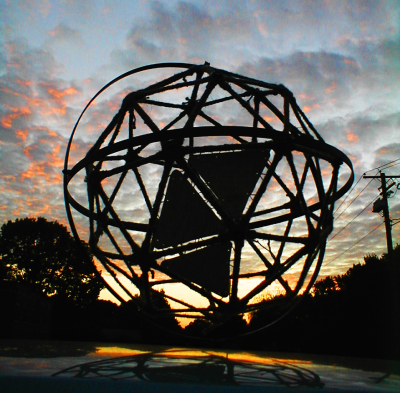 The Philadelphia Fullerine at sunset | |
Credit where Credit is due
Many people have been very helpful in this project. I could not done it without their help:
- The Library Company of Philadelphia granted me free reproduction rights for the sculpture and gave me countless hours of help. Props to Phil Lapansky, Charlene Peacock, and many others.
- The Free Library of Philadelphia provided me with as many images as did the Library Company. They also graciously allowed me to reproduce historical images on my sphere.
- The Henry Mercer Museum provided inspiration and information. If you want to see what life in the United States was like before industrial times, visit this museum. It's one of my top three favorite museums.
- The Philadelphia Fire Museum provided me with some images and an entertaining morning. Their museum is a fine tribute to the men and women of Philadelphia's fire departments throughout history. I could gab with their staff forever.
- The Elizabethtown College Admissions Office graciously lent me some photographic equipment to get digital versions of many of the images. Thanks for your generosity!
- My father and mother, Jorge and Karin Matias, helped make the idea a reality. My dad, a fabricator, made some connectors and helped me construct the sphere. My mother worked with me to cut balsa and place the photographs in place. Both parents were up late the weekend before the conference, helping me wind jute and lace the triangles. Their constant support as parents, educators, and friends has defined who I am. Thanks, Mom and Dad!
- Got Milt? Professor Friedly was my advisor for the project and gave me good guidance as I built the sphere and its base. Thanks!
- Dr. Winpenny, author of numerous books about historical themes (including recent ones on the Phoenix Bridge Company and the Manhattan Bridge), grew up in Manayunk, Philadelphia. He pointed me in all the right directions for my research and has been an incredibly knowledgeable, wise instructor. He is my second reader for the thesis project.
- Dr. Kevin Scott, director of the English Education program at Elizabethtown College, is my first reader on the thesis committee. He lent me equipment and gave me some good ideas for the project. The other talk I gave at NCHC was a collaboration with Dr. Scott, who is a great conversationalist on nearly anything that requires careful thought.
- The Hershey Food Honors Program at Elizabethtown College directed by (the incredibly awesome) Conrad Kanagy, which has been consistently encouraging me to dream big and do bigger. Cash and encouragement are nice, and encouragement is the most valuable.
- Ken Milano, of the Kensington Historical Society, provided me with numerous images and many ideas. He's one of the best historians I know, not just because he knows his stuff, but because he gives his time and life back to the community he studies.
Contact Information
Are you interested in geodesics? In hypertext? In narrative sculpture? Drop me a line by sending an email to jnm@rubberpaw.com. I'm currently looking for more places to exhibit this work, so if you have any ideas, please let me know.